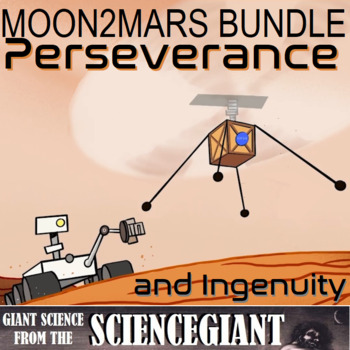Moon2Mars: Perseverance and Ingenuity Mars Mission
- Zip
Products in this Bundle (9)
showing 1-5 of 9 products
Description
NASA's Mars duo of the rover Perseverance and the helicopter Ingenuity arrived at the red planet and touched down inside Jezero Crater on February 18th, 2021. With this bundle of low-cost, high-impact activities, Ss can practice designing, building, and landing their own Mars mission. Bring the exciting engineering and science of a Mars mission to students in the classroom and at home with STEM lessons and do-it-yourself projects covering topics such as biology, geology, physics, mathematics, engineering, coding and language arts.
After the drop off, the duo separated so Perseverance could continue to look for signs of past life in a region of Mars where the ancient environment is believed to have been favorable. And Ingenuity, a small, autonomous rotorcraft, will then become the first aircraft to fly on the Red Planet in March 2021 to scout ahead. The helicopter is an experiment designed to attempt the first powered, controlled flight on another planet.
A key goal of the rover’s mission is astrobiology, including the search for signs of ancient microbial life. Perseverance will characterize the planet’s geology and past climate, pave the way for human exploration of the Red Planet, and be the first mission to collect samples of Martian rock as well as regolith, which is broken rock and dust.
Note: some activities use food. [BE ALERT TO STUDENT’S FOOD ALLERGY WARNINGS! Products may contain nut and other allergens].
These resources have been classroom tested to help students with the following Florida Next Generation Sunshine State Standards in Science Benchmarks:
- SC.8.E.5.10 Assess how technology is essential to science for such purposes as access to outer space and other remote locations, sample collection, measurement, data collection and storage, computation, and communication of information.
- SC.8.E.5.11 Identify and compare characteristics of the electromagnetic spectrum such as wavelength, frequency, use, and hazards and recognize its application to an understanding of planetary images and satellite photographs.
- SC.912.E.5.7 Relate the history of and explain the justification for future space exploration and continuing technology development.
- SC.912.E.5.8 Connect the concepts of radiation and the electromagnetic spectrum to the use of historical and newly developed observational tools.
__________
Help others Stand on The Shoulders of Giants -- leave a review for this resource! And when you leave a review, you see further. You'll earn 1 credit for every $1 spent on TpT for that resource. Each credit has a value of 5 cents, so 20 credits earned equals $1 you can apply to future TpT purchases.
#StayGiant and stay up on my new resources and STEM news. Look for the green ★ star near the top of any page within my store and click "FOLLOW". Or follow @TheScienceGiant Twitter. Stand on The Shoulders of Giants, and together we'll see further, inspire students, and enlighten inquisitive minds!


